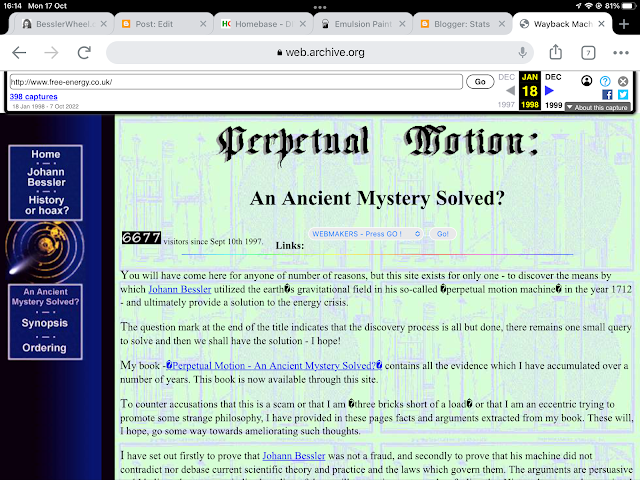I must thank all the kind people who have visited this blog over many years. I have welcomed thousands of comments, some serious some not so.
I’ve posted 754 times and received 28783 comments, had 1688739 visitors, from all over the world. It’s been an excellent experience and hope I’ve managed to spread information about Johann Bessler as far and as wide as possible.
I began to write my biography of Johann Bessler back in 1994, but I couldn’t find a publisher then, although I only approached about 50, but my MS was too long at the time and Bloomsbury publishing said if I could shorten it by half they would consider it. Unfortunately they were taken over by another publisher and their list of potential authors was scrapped. I decided to self-publish although there was little information available at that time. I was not computer literate but I managed. The internet was young and I also designed and posted my first web site in 1997, see below courtesy of ‘the way back machine’
https://web.archive.org/web/19980118081552/http://www.free-energy.co.uk/
Subsequently I had at one time eight web sites, all but one devoted to Bessler, but I let some go but I will continue to keep the current ones, some of which describe the codes and clues I’ve discovered and solved.
I began this blog on 9th February 2009, and I wrote:
“ Why am I writing a blog? I'm not sure, I don't even know for sure what's going to be in it, but I do know that someone (me!) has to get people interested in Johann Bessler also known by the weird name Orffyreus. Having spent most of my life researching the history of this man, I decided to set it all down in a book. The book covers everthing I could find about Bessler but it only scratches the surface of the facts regarding his codes. Yes, he left information about the secret of his machine encoded in his own writings This guy holds the secret to our future energy needs. The fact that he's dead is something of a stumbling block but don't let that put you off. It seems that he left pointers to his secret so all we have to do is find the information, decipher it and build our super new machine for supplying energy. Oh! Did I say he died nearly three hundred years ago? No? Sorry. Fortunately he left behind a huge collection of clues, hints and mysterious pictures all of which form part of the mystery - and the answer. I call it The Orffyreus Code! I know everyone's got codes in their titles, but this one is a real code Now, I've been ranting and raving about good old Johann since 1997 and those who have followed my lead and are now devoted fans form an enormous minority of the worlds population at about 0.000034%. and climbing! Maybe there should be a couple more zeros in there? Enough for now but I'll be back. JC
I’m not giving up on trying to recreate Bessler’s wheel, and I’ve made some important discoveries in Johann Bessler’s clues so I’m confident I can succeed. But the urge to share what I know so far is no longer a temptation because I know that my explanation through this and other web sites will just get lost and maybe ignored among the competing designs, ideas, simulations and actual builds.
There will come a time when I decide to share my information and that will be when either I succeed with a working model, or it fails and I accept defeat. That defeat will allow me to publish everything I’ve discovered and hope there is enough new information to inspire someone else to take forward what I’ve achieved so far.
But if I succeed as I expect, it will be wonderful to prove that Johann Bessler did not lie. How will the world react to that news? How many people quietly working on trying to recreate Bessler’s wheel will be pleased and how many disappointed that they were beaten? How many will claim that they too had succeeded? I don’t know but it seems to me that at this moment in human history, this invention is needed desperately.
I’ve decided to stop posting blogs, for more than one reason. Firstly it’s difficult to keep coming up with a new subject after nine years! Secondly, people get irritated with me because they feel that I don’t keep my promises. I do actually, I try to keep them open ended, but I should recognise that sometimes they aren’t fulfilled as people expect. The trouble is, I’m an incurable optimist, you have to be, in this field of study, and I keep making the mistake of promising too much, too soon, resulting in a lot of disappointment! Finally, this blog was intended to provide an open forum for comments, discussion, airing of views and ideas; but in the recent past it has become infested with trolls and sock puppets. There is, of course, always the option for anyone else to offer something similar or better.
So I’m leaving a brief description of the legend of Bessler’s wheel, and links to all five of my books which always available both digitally and printed hard copy. I will probably return from time to time if I feel I have something of interest, but at the moment I think it will most likely be because I’ve succeeded - or failed! And of course there will be the publication of my own great treatise on the detailed description and meaning of Johann Bessler’s codes and clues.
JC
Where visitors to this blog came from:-





